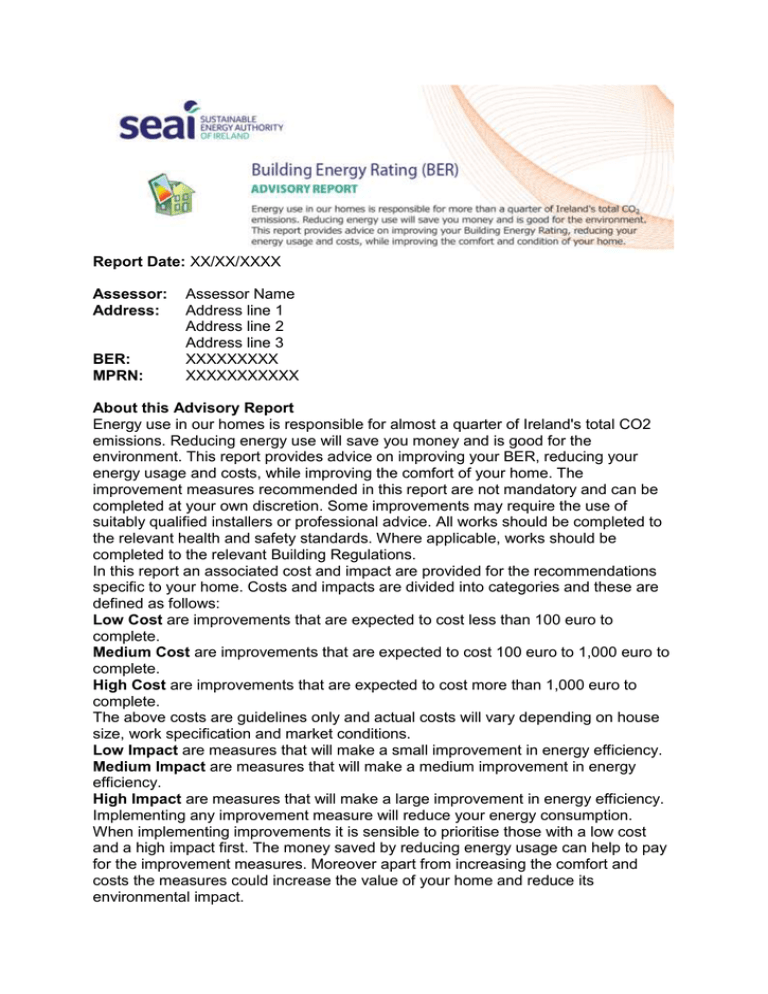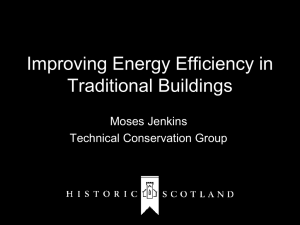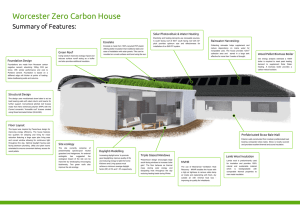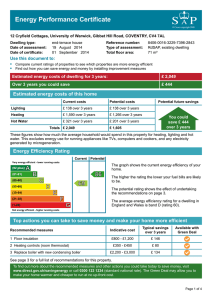Report Date: XX/XX/XXXX Assessor: Assessor Name Address
advertisement

Report Date: XX/XX/XXXX Assessor: Address: BER: MPRN: Assessor Name Address line 1 Address line 2 Address line 3 XXXXXXXXX XXXXXXXXXXX About this Advisory Report Energy use in our homes is responsible for almost a quarter of Ireland's total CO2 emissions. Reducing energy use will save you money and is good for the environment. This report provides advice on improving your BER, reducing your energy usage and costs, while improving the comfort of your home. The improvement measures recommended in this report are not mandatory and can be completed at your own discretion. Some improvements may require the use of suitably qualified installers or professional advice. All works should be completed to the relevant health and safety standards. Where applicable, works should be completed to the relevant Building Regulations. In this report an associated cost and impact are provided for the recommendations specific to your home. Costs and impacts are divided into categories and these are defined as follows: Low Cost are improvements that are expected to cost less than 100 euro to complete. Medium Cost are improvements that are expected to cost 100 euro to 1,000 euro to complete. High Cost are improvements that are expected to cost more than 1,000 euro to complete. The above costs are guidelines only and actual costs will vary depending on house size, work specification and market conditions. Low Impact are measures that will make a small improvement in energy efficiency. Medium Impact are measures that will make a medium improvement in energy efficiency. High Impact are measures that will make a large improvement in energy efficiency. Implementing any improvement measure will reduce your energy consumption. When implementing improvements it is sensible to prioritise those with a low cost and a high impact first. The money saved by reducing energy usage can help to pay for the improvement measures. Moreover apart from increasing the comfort and costs the measures could increase the value of your home and reduce its environmental impact. Ventilation General Operational Advice on Ventilation Care should always be taken to ensure a sufficient level of ventilation to maintain fresh air levels in each room and to remove moisture, water vapour and pollutants. For health and safety reasons it is important to ensure an adequate air supply to combustion appliances e.g. gas, oil or solid fuel. Signs of inadequate ventilation are persistent condensation and mould growth. If such problems exist, they should be addressed first, since reducing ventilation may make the problem worse. In a typical home 20% of all heat loss is through ventilation and draughts. Energy consumption can be improved while maintaining adequate ventilation. If draught sealing is damaged at any time make sure to replace it. When draughtproofing or making houses more airtight, it is important to maintain recommended ventilation standards. Radon concentrations can increase in existing houses as a result of greater airtightness. Further information on Radon is available from the Radiological Protection Institute of Ireland in their publication "Radon in Homes". This guide can be downloaded from www.rpii.ie. Chimneys This dwelling has no chimneys. No specific action is advised. Fan & Vents This dwelling has one or more fans/vents. The fans and vents in this dwelling increase heat loss by allowing heated air to escape but can be important in ensuring adequate ventilation. If there is no cover on the inside of the vents, installing controllable vent covers will allow you to control the air flow through the vents, and so can help reduce heat loss. It is important not to permanently close or cover over air vents as they are required to provide ventilation for the removal of moisture, pollutants and operation of combustion appliances. It is important for safety reasons to have proper ventilation in any room which contains combustion appliances. For further details please refer to publication 'A Detailed Guide to Insulating Your Home' available on www.seai.ie. Cost: Low Impact: Low Draught Lobby This dwelling has no draught lobby. Open doors and air gaps around doorways are a source of heat loss in a dwelling. The construction of a draught lobby/porch on the frequently used external doorways in this dwelling would reduce these heat losses. Lobbies should be constructed to the relevant Building Regulations. Care should be taken not to block any existing ventilation openings inadvertently. Cost: High Impact: Low Suspended Wooden Floor This dwelling has a sealed suspended wooden floor. No specific action is advised. Draught Stripping This dwelling has 100% draught stripping. No specific action is advised. Ventilation System This dwelling has natural ventilation. No specific action is advised. Building Elements Floors General Operational Advice on Floors Floors can be a source of significant heat loss and dampness in a dwelling. For example heat loss through the ground floor of a two storey house typically accounts for about 10% of total heat loss. For a single storey house this figure is about 15%. However, if a house is well insulated everywhere except for the ground floor, this percentage will be higher. A U-Value is a measure of the heat loss through the fabric of the building. The lower the U-Value the better and the higher the U-Value the greater the heat loss. Floors with a U-Value greater than 0.25 could be improved in a number of ways. A relatively simple way to reduce heat loss through a ground floor is to lay a carpet with foam backing or a foam underlay ensuring that both carpet and underlay are laid wall to wall. Sealing of gaps in the ground floor will help to reduce draughts. Modern insulation methods for new houses may also be implemented in existing houses. In some cases this would be disruptive and costly, but if work needs to be done on the floor anyway, this is a good time to consider an insulation upgrade. For further details please refer to publication 'A Detailed Guide to Insulating Your Home' available on www.seai.ie Part of the floor area in this dwelling has a U-Value of less than 0.6 and greater than 0.25. The insulation in this floor can be improved. Cost: High Impact: Low Roofs General Operational Advice on Roofs Proper insulation will help retain valuable heat and improve overall comfort levels. If insulation is disturbed or damaged at any time, e.g. in attic space, make sure to restore or replace it. Heat loss through an un-insulated roof of a typical house can account for up to 30% of the total heat loss. Installing insulation will reduce this heat loss, and hence reduce the energy demand of the dwelling. A U-Value is the measure of the heat loss through the fabric of the building. The lower the U-Value the better and the higher the U-Value the greater the heat loss. Modern pitched roofs or habitable roof spaces that are insulated between the rafters, have a U-Value less than or equal to 0.2. Modern flat and pitched roofs that are insulated at ceiling level, have a U-Value less than or equal to 0.16. Blanket insulation, rigid board insulation or expanding foam may be used to achieve the required insulation level. Loose beads may also be used for roofs insulated on the ceiling. Installing roof insulation generally involves a considerable amount of work. The attic/roof space must have adequate ventilation to prevent dampness. This is achieved by leaving a continuous air gap along the eaves at each side. Electric cables should not be buried under insulation. Leave clearance for recessed lights to avoid them overheating. For further details please refer to publication ' A Detailed Guide to Insulating Your Home' available on www.seai.ie Part of the pitched roof insulated on the rafter or room in roof in this dwelling has a UValue of less than 0.4 and greater than 0.2. The insulation in this roof can be improved. Cost: High Impact: Low Part of the pitched roof insulated on the ceiling in this dwelling has a U-Value of less than 0.4 and greater than 0.16. The insulation in this roof can be improved. Cost: Medium Impact: Low Walls Heat loss through the walls can account for up to 30% of the total heat loss. This can typically be reduced by two-thirds by insulating the walls and so reduce the energy demand of the dwelling. A U-Value is a measure of the heat loss through the building fabric. The lower the U-Value the better and the higher the U-Value the greater the heat loss. Walls with a U-Value greater than 0.27 could be improved. Insulation may be installed as cavity fill. This is where the gap between the inner and outer layers of external walls is filled with an insulating material. If cavity insulation is not applicable or is not technically possible, insulation may be installed internally or externally. Internal insulation involves a layer of insulation being fixed to the inside surface of external walls, and a suitable fire resistant finish being incorporated or applied. External solid wall insulation is the application of an insulant and a weatherprotective finish to the outside of the wall. For further details please refer to publication 'A Detailed Guide to Insulating Your Home' available on www.seai.ie Part of the wall area in this dwelling has a U-Value of greater than or equal to 1.1. The insulation in this wall can be greatly improved. Cost: High Impact: High Part of the wall area in this dwelling has a U-Value of less than 0.6 and greater than 0.27. The insulation in this wall can be improved. Cost: High Impact: Low Windows Glass allows heat to escape more readily than most other building materials. For this reason, it is important that the windows are as energy efficient as possible. Windows can account for around 15% of the heat loss in your home. Installing energy efficient windows such as low-E double glazing helps to retain heat and improves comfort through elimination of cold window surfaces and associated downdraughts and condensation. The use of shutters, lined curtains and blinds can improve heat retention at night and further reduce downdraughts. A U-Value is a measure of the heat loss through the building fabric. The lower the UValue the better and the higher the U-Value the greater the heat loss. Windows with a heat loss greater than the current building standards (i.e. have a U-Value greater than 2) could be improved. The best benefits are achieved through replacing single glazed windows with low-E double glazing or triple glazing. Note that single glazing can also be improved by adding secondary glazing (installing a secondary window and frame on the room side of the existing window). Some of the windows in this dwelling with a U-Value of greater than or equal to 4. The heat loss through these windows can be greatly reduced. Cost: High Impact: High Some of the windows in this dwelling with a U-Value of less than 4 and greater than or equal to 2.7. The heat loss through these windows can be significantly reduced. Cost: High Impact: Medium Doors Heat is lost from dwellings through doors which often have relatively poor thermal insulation compared to other elements of the building. Installing insulated doors will reduce this heat loss, and also generally reduce draughts through air gaps at the frames. Replacement doors, whether glazed or half glazed, should have insulated cores. A U-Value is a measure of the heat loss through the fabric of the building. The lower the U-Value the better and the higher the U-Value the greater the heat loss. Doors with a U-Value greater than 2.0 could be improved. For further details please refer to publication 'A Detailed Guide to Insulating Your Home' available on www.seai.ie Part of the door area in this dwelling has a U-Value of less than 4 and greater than or equal to 2.7. The heat loss through this door area can be significantly reduced. Cost: Medium Impact: Low Hot Water General Operational Advice on Hot Water. Ensure that the hot water cylinder insulation is not disturbed or damaged. Incomplete insulation increases heat loss and costs money. A cylinder thermostat is not required for the hot water system in this dwelling. No specific action is advised. Hot Water Cylinder Insulation The hot water cylinder has factory fitted insulation. No specific action is advised. Lighting General Operational Advice on Lighting Compact Fluorescent Lamps (CFLs) use 20% of the energy used by typical incandescent bulbs to give the same amount of light. A 22 Watt CFL has the same light output as a 100 Watt incandescent. LED (Light-emitting diode) lights use less than 10% of the energy required for corresponding tungsten lights. Low energy lighting will give highest savings in rooms that are most often used. Lighting - Low Energy Bulbs The low energy lighting in this dwelling is greater than or equal to 50% but but less than 100%. Replacement of traditional light bulbs (tungsten or incandescent) with energy saving bulbs (CFL or LED) can reduce lighting costs significantly. They also last considerably longer than ordinary light bulbs thereby saving on replacement costs. Consider replacing traditional light bulbs with energy saving bulbs. Cost: Low Impact: Low Space Heating General Operational Advice on Space Heating A reduction of 1oC on your thermostat can reduce annual space heating costs by 10% or more. An automatic timer switch or programmer allows you to schedule the heating duty on the hot water and heating system and to turn the system on and off as required. Use this facility to limit the running time for the heating system to fit your specific needs and you will save money. Room thermostats nomally turn the boiler and heating circulation pump off when the room temperature has reached the desired level. A room thermostat is normally located in a living area or circulations area (hall or landing). Guide temperature settings are 20oC for a living room and 16 18oC for circulation areas. However, the most appropriate setting depends on location of the thermostat and the heating system design. Choose the lowest setting that gives acceptable comfort conditions. Finding the setting to suit you may take some experimentation. Thermostatic Radiator Valves (TRVs) can be set to suit the heating requirements of the room(s) in question. For further details please refer to "A Detailed Guide to Home Heating Systems" available on www.seai.ie Distribution System Losses and Gains (Control Category) The heating system controls in this dwelling could be improved. The heating system would benefit from a programmer/timer and room thermostat to enable the boiler to switch off when no heat is required. A seven day programmer will allow you to customise a heating schedule to meet your specific heating needs for each day of the week. This would reduce the amount of energy used and lower your fuel bills. Thermostatic radiator valves (TRVs) could also be installed to allow the temperature of each room to be controlled to suit individual needs, adding to comfort and reducing heating bills. For example, they can be set to be warmer in the living room and bathroom than in the bedrooms. TRVs should be fitted to every radiator excluding the radiator in the same room as the room thermostat and to the radiator/towel rail in the bathroom. The room thermostat is needed as well as the TRVs, to enable the boiler to switch off when no heat is required. Cost: Medium Impact: Medium Main Heating System General Operational Advice on Main Heating System You should have your boiler professionally serviced at least once per year. A clean and serviced appliance will operate more economically and will have a longer service life. Efficiency of Main Heating System (Gas or Oil) This dwelling has an oil/gas main heating system. The efficiency of the boiler is greater than or equal to 70% but less than 80%. If your boiler is over 15 years old and/or has an efficiency of less than 80% you should consider upgrading it to a condensing boiler. A condensing boiler is capable of much higher efficiencies than other types of boiler, meaning it will burn less fuel to heat this dwelling. Boilers with an efficiency of over 90% are available on the market. While boiler upgrades can be undertaken at your own discretion, please note that, in the case of replacement boilers, it is a mandatory requirement under current Building Regulations that a replacement boiler has a minimum efficiency of 86%. When an old boiler is due for repair or replacement it is usually more cost effective to replace it with a condensing boiler. Condensing boilers need a drain for the condensate which may limit where they can be located. This can be borne in mind if you are considering remodelling the room containing the existing boiler even if the existing boiler is to be retained for the time being. Renewable or Low Carbon heat sources should also be considered as replacements for oil or gas boilers. Two such alternatives are biomass boilers and heat pumps. A biomass boiler burns renewable fuel such as wood pellets and therefore is less damaging to the environment than fossil fuels. Heat pumps transfer the heat stored in the ground or outside air into the home for heating or hot water. Biomass boilers could also be considered as a low carbon dioxide direct alternative to a gas or oil boiler. Biomass boilers usually require more fuel storage space than gas/oil boilers. Heat pumps could also be used to improve energy consumption levels but are not as easily retrofitted, particularly when the dwelling does not have underfloor heating. Cost: High Impact: High Thermal Solar Panels This dwelling has no solar water heating. Solar Panels, also known as "collectors", can be fitted to a building's roof. They use the sun's heat to warm water, or another fluid, which passes through the panel. The fluid is then fed to a heat store (e.g. a hot water tank) and helps provide hot water directly or can provide a source of hot water for the central heating system in the dwelling. Solar panels work throughout daylight hours, even if the sky is overcast and there is no direct sunshine. Solar panels can also be used to meet some space heating demand. Ideally the panels should be located on an unshaded, south facing roof at a tilt angle of 30°- 45° to the horizontal. Space will be need to accommodate an appropriately sized cylinder for the system and a thermal mixing (anti-scald) valve should also be installed. Cost: High Impact: Medium PV Solar System or Microturbine This dwelling has no Photo Voltaics (PV) or Microturbine installed. A solar photovoltaic (PV) system is one which converts light directly into electricity via panels placed on the roof with no waste and no emissions. This electricity is used throughout the home to supplement the electricity purchased from an energy supplier. Ideally the panels should be located on an unshaded, south facing roof at a tilt angle of 30°- 45° to the horizontal. Batteries can be used to store electricity from the PV array or wind turbine. However, this increases the installation and equipment cost as well as maintenance cost. A Micro-windturbine is a small turbine placed on the property which uses wind to generate electricity. The electricity is used throughout the home to supplement the electricity from an energy supplier. The turbine should not be subject to wind shelter. To be effective, the turbine should be at a height well clear of nearby roofs and other obstructions. Cost: High Impact: High General Advice on Energy Use in Your Home The way we use energy in our homes can reduce energy consumption. Some simple everyday measures will save money, improve comfort and reduce your impact on the environment. Some of these are outlined below. Appliances: New kitchen appliances carry an energy rating label which rates energy efficiency on a scale of A to G. When buying new appliances look for A rated products which are more energy efficient and cost less to run. Do not under or overload appliances, such as dishwashers and washing machines. For washing machines, a 40ºC rather than a 60ºC wash cycle cuts electricity use by approximately a third. (Modern washing powders and detergents can work equally effectively at lower temperatures.) Defrost your freezer regularly to save energy and extend the operating life. Equipment on standby uses up to 20% of the energy it would use when fully on. When an appliance is not in use, turn it off fully. Lighting: Avail of natural daylight whenever possible and avoid leaving electric lights switched on in unoccupied rooms. All lighting lamps carry an energy label similar to that on appliances (i.e. an A to G label) so always choose the most efficient to suit your particular needs. Useful Links and Sources of Further Information Useful energy saving tips are available on www.change.ie (Tel. 1890 242643) and www.powerofone.ie. For specific queries on BER please contact SEAI on 1890734237 or by email info@ber.seai.ie. There are many useful documents available on The Sustainable Energy Authority of Ireland's (SEAI) website www.seai.ie The most recent Technical Guidance Documents for the Building Regulations and other supporting documents are available from the Department of Environment, Heritage and Local Government website www.environ.ie on the link to Building Standards (Tel. 1890 202021). Some of these documents are listed below. Technical Guidance Document Part L Conservation of Fuel and Energy - Dwellings; Technical Guidance Document Part J Heat Producing Appliances; Technical Guidance Document Part F Ventilation. When performing building works it is important to take the correct health and safety measures. Useful health and safety information on ventilation, radon and combustion devices can be found on the Carbon Monoxide safety website: www.carbonmonoxide.ie Tel. 1850797979 and The Radiological Protect Institute of Ireland website www.rpii.ie/radon Tel. 01 269 77 66. Please consider the environment before printing this document




